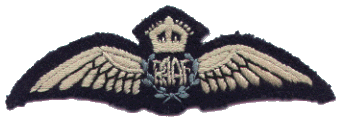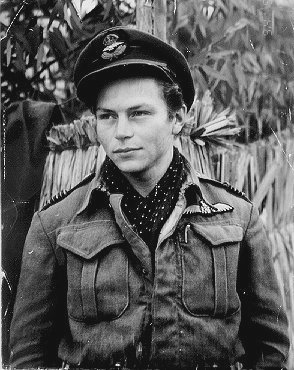
Miscellaneous Comments, Photos, Insights, etc.
Here are some of the oddities I've come across and observations I've
made while conducting research for my book.
[Wartime vs. Postwar battledress] [Visor Caps]
[Eagle Squadron Patches] [RCAF battledress]
Eagle
Squadron Patches The patches I have are known reproductions and are very nearly exact copies of one of the many official patterns used by the 3 Eagle Squadrons. I've occasionally seen ES patches being offered for sale as originals and have tried to obtain images of them whenever possible. I have no idea as to the authenticity of any of the items shown. I do know that several variant patterns existed and the items shown illustrate this fact. As to wearing the patches, there are several schools of thought. One would think they should be worn with the eagles facing rearwards as is the case with the Other Ranks shoulder eagles. However, numerous photos exist of ES patches being worn in a variety of configurations: -- Eagles facing rearward; facing forward, both facing the same direction (either left or right); or only being worn on one arm. The most common seems to be eagles facing forwards. If anyone can identify any of these patterns as either repros or originals, please let me know and I'll update the info.
|
|
| Air Force Battledress
Blouses I've had a lot of e-mails asking about battledress blouses lately. It seems that there are a lot of supposed "original WW2" blouses being offered that are clearly postwar. The sellers appear to be taking advantage of the buyers lack of knowledge and also preying on the desperation of many collectors and reenactors to acquire Air Force BD at any cost. Here's my down-and-dirty guide to Air Force battledress: Wartime Wool Blouses: Wartime Cotton Blouses: Postwar Blouses: Mix-and-Match: |
right-click on image and select "view image" to see larger version of uniform
|
| Visor Caps -- Welting, Buttons and
Crescents There seems to be a great deal of confusion in determining wartime visor caps from postwar caps. The accepted standard seems to be, incorrectly, that a proper wartime visor cap has all of the following features: Square visor, no beading (piping) at the crown seam, flat buttons, and white stitching at the crown seam. The lack of decent reference material and scarcity of decent photographs has only served to further ingrain this erroneous information into the collecting community. When Mick Prodger's books came out (which I highly recommend buying), the few cap photos only served to reinforce the above misconceptions. Visor Shapes: Many makers, including Bates and the rest of the Savoy Row tailors, produced a wide range of caps with both square and crescent-shaped visors. Welting: Wartime visor caps often have welting (beading) between the crown seam and body of the cap. The cap at the right was made in Toronto in 1942 and features the crown welt. Look closely at many photos of AVM Keith Park. Most of the time his caps have the welting present. Buttons: Lastly comes the great button debate: Flat, cloth-covered versus everything else. While most (but not all) Brit-made visor caps tend to have the flat buttons (and still do today), a large number of caps can be found with a variety of button styles. The most common seems to be cloth-covered, domed-shaped buttons. There are also black-painted flat or domed buttons out there, as well. RAAF visor caps are the only ones seen with one style of button. These had black bakelite buttons embossed with the RAF eagle and crown. Postwar RAAF caps had gilt buttons. |
above: The stereotypical wartime cap: white stitching at crown seam, flat buttons, square visor, no seam welting. Dated 1944. below: Another wartime cap. Blue/black stitching, cloth-covered dome-shaped buttons, square visor, seam welt present. Dated 1942. |
| RCAF Type D battledress? Ever heard of it? Probably not. According to the regulations, it doesn't even exist! From the few photos available, these seem to have been primarily issued to Coastal Command crews. The blouse is similar to a normal blue-grey BD with the exception of having a zipper front. The familiar waist belt is gone, as well. There is a stubby tab that buttons in place -- identical to Royal Navy BD. I have two of these blouses now -- both dated 1944 by T. Eaton of Montreal, Canada. The wing is the '48-53 pattern used by radio operators.
|
|
| RCAF Battledress: Do
you know the difference? While Canada utilized many of the basic patterns developed by the RAF, there are subtle variations that many people may not have noticed. For example, did you ever stop and look at the pocket flaps? I have seen several people pass up authentic RCAF battledress blouses at militaria shows because the pocket flaps were single-pointed, not the 3-pointed, scalloped type so commonly seen in photos. These individuals dismissed them as fakes or postwar issue by other countries, especially if the labels were missing. Many, but certainly not all, Canadian manufacturers adhered to the British pattern down to the smallest detail. Others, mainly those producing Army BD in khaki, chose to simplify the number of patterns being used and simply made Army pattern BD using blue-grey serge. These blouses feature the "pointed" style of pocket flaps seen on Brit/Commonwealth army BD. They always have pleated pockets and covered buttons -- no exceptions. Reported "Austerity Pattern" RAF BD did not exist. Lining material on these Canadian-made versions range from sky-blue drill to dark grey or black. A common feature is the use of the Canadian Army-style tab and button across the throat instead of the typical metal hooks. These blouses are very much authentic WW2 BD and not Belgian or Norwegian postwar issue (although both Belgium and Norway both used a similar style BD in the immediate postwar years). |
 |
| While not an oddity, I think this BD is pretty
cool. Canadian Army issue BD ('43-dated) but issued to an RCAF F/O. The blue badging is
very visible against the olive material. I also have a similarly badged RAF example which
is in relic condition. This uniform was required dress for aircrew assigned to the 2TAF in
summer/fall of 1944. |
|